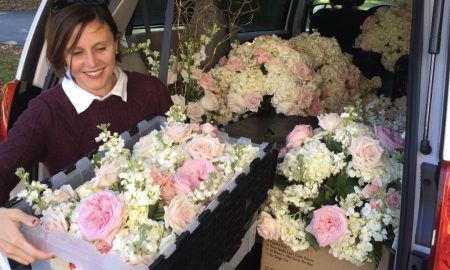

Today we’d like to introduce you to Trina Teele.
Trina, please kick things off for us by telling us about yourself and your journey so far.
Art has always been soothing for me. It’s a therapy I’ve used and still use to get in touch with and listen to my inner thoughts and feelings with complete acceptance.
As a young child I enjoyed art classes and quickly became known by my classmates as “artistic.” I entered college with the intention of becoming an art teacher, as I come from a family of teachers. However, about halfway through the program I developed imposter syndrome: if I was not (yet) an artist, how could I possibly teach art to others? At that point I switched my major to Painting with a Graphic Design concentration, and I focused on developing my identity as an artist.
I remember one adviser and painting teacher really struck a chord with me when he told our class that 5 years after graduation, most of us would never pick up a paintbrush again. I was determined to not let that be me. Several years after graduating, as a graphic designer and a new mom, I made sure to get the paintbrush in my hand whenever possible. But it wasn’t until my children were mostly grown that I really went back in deep with my art.
I decided to paint in series so that I could explore a single subject at a time. Later, I made the commitment to do something “creative” every day, as a way to remind myself that I was still an artist. It didn’t take long to genuinely call myself an artist again.
My artwork over the past 10 years reads like a diary to me. I look at the more prominent series of works and they connect to different times in my life when I was working through various issues: be it midlife searching for presence and meaning, handling reality before and after taking a gene test, or coping with my father’s life and death.
Can you give our readers some background on your art?
My art usually starts with a plan: I have an idea, a vision, a structure. I also have music to keep me dedicated. At some point, the plan is surrendered and the painting and I begin a new dialog. It becomes collaborative. I never know where it will go, but it is an undertaking that keeps me coming back for more.
These days I have been painting primarily nautical pieces using oil paints: lots of water, boats, and reflections. These seascapes remind me of my childhood visiting family on Nantucket, Martha’s Vineyard and Long Island. I began this series at the same time my dad was succumbing to the late stage symptoms of Huntington’s Disease. He was disappearing into his own world, and I knew I would never be able to talk with him about my childhood.
My father was a sailor and thrill seeker. He loved the sea and wanted nothing more than to have everyone in his family feel the same. As a child I loved the sea, but sailing scared me. Memories of “too many captains” and shouting stuck out in my mind when I thought of our sailing ventures. It made me feel unsafe and I knew I needed to process that. By painting the ocean – and boats in particular – I could test the waters of my memories and was able to see them with a new perspective. I wanted to embrace my dad’s passion.
Prior to his death, I painted many boats at rest at their moorings. Notably, after he died, I started to paint boats that were actually in motion. I began really searching for that thrill that I know he loved and I was able to find peace with my memories.
I’ve found that being creative makes me feel good — like daily exercise or meditation. In my journal, I wrote:
Painting can feel like riding a wave into shore.
It is thrilling and has moments that feel ‘out-of-body.’
Like listening to music, it rouses an emotion. I love creating art, and when people look at my paintings, I hope they feel a similar feeling to what I do when I create them.
We often hear from artists that being an artist can be lonely. Any advice for those looking to connect with other artists?
It’s good to get to know as many artists as you can – over the years I’ve met artists at gallery openings, demonstrations, lectures and classes. It’s fun to arrange “plein air” dates when the weather allows. Nowadays, I’ve found that Facebook is a great way to keep conversations about art going.
What responsibility, if any, do you think artists have to use their art to help alleviate problems faced by others? Has your art been affected by issues you’re concerned about?
As I meet more and more artists, I am learning that people who consider themselves artists often see things quite differently from those who don’t. I think it is important to share perspectives and look for common ground. As for my art being affected by my concerns – absolutely!
What’s the best way for someone to check out your work and provide support?
I have a studio at the Chelmsford Center for the Arts in Chelmsford, MA. We hold open studios on the second Saturday of every month from 1-4 pm. I also exhibit locally at various events and juried shows. I am currently represented by NOA Gallery in Groton.
Contact Info:
- Address: Chelmsford Center for the Arts
1a North Road
Chelmsford, MA - Website: www.trinateele.com
- Email: kcteele@gmail.com
- Instagram: www.instagram.com/trina_teele/
- Facebook: www.facebook.com/TrinaTeeleArtist
- Other: trinacreative.blogspot.com/






 Image Credit:
Image Credit:
Julia Teele, Trina Teele
For garden photo: This is a photo my daughter took at our family home on Martha’s Vineyard. I’d made a commitment to daily “plein air” painting for the month of July. I spent many days in this garden that my sister created, where my dachshund was always by my side.
Getting in touch: BostonVoyager is built on recommendations from the community; it’s how we uncover hidden gems, so if you know someone who deserves recognition please let us know here.
















